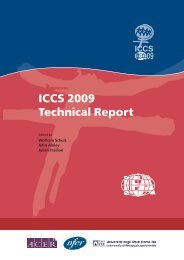Teacher Education and Development Study in Mathematics - IEA
Teacher Education and Development Study in Mathematics - IEA
Teacher Education and Development Study in Mathematics - IEA
You also want an ePaper? Increase the reach of your titles
YUMPU automatically turns print PDFs into web optimized ePapers that Google loves.
26<br />
TEACHER PAY AND STUDENT MATHEMATICS ACHIEVEMENT<br />
Results of the teacher salary case studies<br />
The 20 countries that we studied represent a wide array of economic development<br />
levels <strong>and</strong> national education policy structures. In many, teacher labor markets,<br />
teacher-education policies, <strong>and</strong> school<strong>in</strong>g curricula are controlled by national<br />
education m<strong>in</strong>istries. In others, policies are set <strong>in</strong> a much more decentralized fashion.<br />
For example, <strong>in</strong> Botswana <strong>and</strong> Ch<strong>in</strong>ese Taipei, education policy is highly centralized,<br />
whereas <strong>in</strong> the United States, teacher salary structures are often determ<strong>in</strong>ed by school<br />
districts, <strong>and</strong> teacher-education st<strong>and</strong>ards are set by states but implemented by highly<br />
autonomous university faculties of education. Germany is also highly decentralized <strong>in</strong><br />
terms of educational policies <strong>and</strong> education recruitment <strong>and</strong> tra<strong>in</strong><strong>in</strong>g, but the federal<br />
government sets salaries nationally.<br />
Table 2 presents a brief summary of the ma<strong>in</strong> aspects of the country case studies<br />
presented <strong>in</strong> Part 2 of this report. Almost all of the countries surveyed require primary<br />
<strong>and</strong> secondary teachers to have a university degree, but there are still many teachers<br />
<strong>in</strong> most countries without this qualification. In most countries, the vast majority of<br />
primary teachers are women. But this is not usually the case <strong>in</strong> the secondary schools of<br />
many countries, where the majority of the secondary school labor force is male. <strong>Teacher</strong><br />
labor forces also vary considerably <strong>in</strong> their age distribution, with countries such as<br />
Germany <strong>and</strong> Italy employ<strong>in</strong>g a relatively old teach<strong>in</strong>g force, <strong>and</strong> other countries, such<br />
as the United K<strong>in</strong>gdom, hav<strong>in</strong>g a much younger teach<strong>in</strong>g force.<br />
Our ma<strong>in</strong> focus <strong>in</strong> regard to the country studies was on teacher pay relative to the pay<br />
of other professions, particularly mathematics-oriented professions. <strong>Teacher</strong>s <strong>in</strong> all these<br />
countries are generally paid at the same rate whether they teach mathematics, science,<br />
or other subjects. Thus, we compared the pay of teachers as an occupational group<br />
with the pay of other professionals with similar education, <strong>and</strong> we also bisected this<br />
comparison by gender. Where possible, we collected separate data for primary <strong>and</strong><br />
secondary school teachers, given that secondary school teachers usually have different<br />
educational requirements <strong>and</strong>, <strong>in</strong> some countries, receive higher rates of pay.<br />
Table 3 shows teacher salary ratios <strong>in</strong> the early 2000s for the 20 countries we studied.<br />
We estimated this ratio by measur<strong>in</strong>g the ratio of median earn<strong>in</strong>gs of teachers with<br />
Bachelor’s degrees to the median earn<strong>in</strong>gs of those <strong>in</strong> scientific occupations with<br />
Bachelor’s degrees, as well as <strong>in</strong> relation to the age brackets of 25 to 29, 30 to 34, <strong>and</strong><br />
35 to 39 (or 35 to 44 <strong>in</strong> those countries where the 35 to 39 category was not available).<br />
Our assumption <strong>in</strong> sett<strong>in</strong>g the age range from 25 to 39/44 was that the relative pay<br />
offered to workers dur<strong>in</strong>g their first 15 to 20 years of work life is an important factor<br />
determ<strong>in</strong><strong>in</strong>g workers’ choice of occupation. 4 We then averaged the three ratios to get<br />
the figure <strong>in</strong> Table 3 for each country. We estimated this ratio for males <strong>and</strong> females<br />
separately. We also measured the ratio of male to female earn<strong>in</strong>gs at the three ages for<br />
the science-based occupations. (For some countries, we could have measured ratios of<br />
relative hourly earn<strong>in</strong>gs, but the number of these ratios available was too small to allow<br />
for relevant comparisons with student test scores. We therefore limited ourselves to<br />
us<strong>in</strong>g median annual earn<strong>in</strong>gs.)<br />
4 The gradients of teacher salaries vary from country to country. In some, such as Australia, teacher salaries start<br />
out relatively high but are relatively flat <strong>in</strong> later years. In others, such as Korea <strong>and</strong> France, start<strong>in</strong>g salaries are<br />
relatively lower <strong>and</strong> the gradient is steeper, which means that senior teachers earn relatively high salaries. Because<br />
our estimates give greater weight to the earlier salaries, our results may be somewhat biased.

















